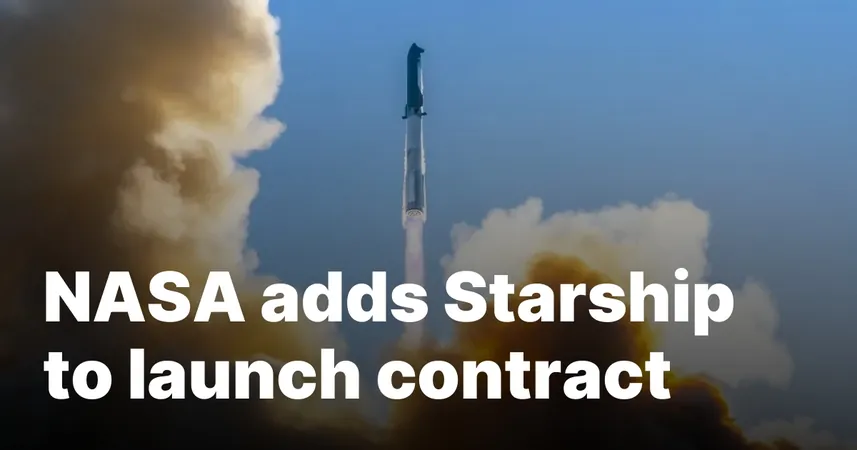
NASA Welcomes Starship to Its Mission Launch Lineup—But There's a Catch!
2025-03-31
Author: Yan
NASA has officially added SpaceX’s ambitious Starship to its NASA Launch Services II (NLS II) contract, marking a significant milestone for the agency. However, before Starship can take to the skies for major missions, there’s a considerable amount of work to be done and hurdles to overcome.
NASA's Announcement
Back on March 28, NASA made the announcement that Starship would now be part of the NLS II contract, which serves as a primary mechanism for securing launch services for various science and exploration missions. Currently, SpaceX's Falcon 9 and Falcon Heavy rockets are included in this contract and have been used several times recently for missions like the SPHEREx astrophysics spacecraft launch on March 11, 2023, alongside the PUNCH space science mission.
Risk Levels for Starship
Starship's addition is exciting, but it does not immediately qualify the vehicle to compete for all NASA launches. NASA categorizes vehicles under NLS II into three risk levels based on their flight history and reliability. Starship will initially fall under the highest risk category (Category 1), which includes vehicles that have not yet conducted their inaugural flights. This means it will only be eligible for low-cost NASA missions designated as Class D, which accept a higher degree of risk.
For vehicles classified as Category 2, they must have completed one to six consecutive successful launches, and are appropriate for missions of moderate risk tolerance (Class C and D). Vehicles in Category 3, which are considered low risk and have completed three to 14 successful launches, can be utilized for all mission classes, including high-stakes ventures such as NASA's Europa Clipper and the Roman Space Telescope.
Immediate Goals for Starship
Despite the uncertainty surrounding Starship's readiness for typical launches, its primary immediate goal will be serving NASA’s Human Landing System (HLS) program. This involves the development of a lunar lander version set to support the Artemis 3 and 4 crewed lunar landings in the coming decade.
Regulatory Advances and Communication Permissions
On the regulatory side, SpaceX is making strides to facilitate this ambitious development. The company has filed an application with the Federal Communications Commission (FCC) to secure the necessary communication permissions for Starship operations. This application, accepted by the FCC on March 27, seeks authorization for essential communications that will ensure the vehicle's efficiency and support integration into NASA’s Artemis missions.
SpaceX's Commitment and Operational Parameters
SpaceX expressed enthusiasm about being entrusted with such a crucial part of NASA's Artemis campaign: "We are honored that NASA has selected the Starship launch vehicle and its variants for such significant missions," stated the company in their application. They’re aiming to maintain American leadership in space while facilitating the launch of future satellite technologies and human-crewed spacecraft.
The application details operational parameters that Starship will adhere to, including its operational altitudes from 181 to 381 kilometers in low Earth orbit for satellite endeavors and propellant transfer missions. The company also outlined its plans for a specialized "Final Tanking Orbit" to support crewed lunar missions, along with the necessity for operations in low lunar orbits—crucial for attaining success in NASA's future lunar explorations.
Conclusion: The Future of Space Exploration
NASA’s utilization of Starship is not just about getting to the moon; it’s about laying a foundation for long-term space exploration and establishing reliable transportation for astronauts and equipment. As we ready ourselves for a new era of space discovery, all eyes are on SpaceX to see if they can rise to the occasion with their revolutionary vehicle. Will Starship soar to success, or will it face major setbacks? The answers may redefine the future of space travel!



 Brasil (PT)
Brasil (PT)
 Canada (EN)
Canada (EN)
 Chile (ES)
Chile (ES)
 Česko (CS)
Česko (CS)
 대한민국 (KO)
대한민국 (KO)
 España (ES)
España (ES)
 France (FR)
France (FR)
 Hong Kong (EN)
Hong Kong (EN)
 Italia (IT)
Italia (IT)
 日本 (JA)
日本 (JA)
 Magyarország (HU)
Magyarország (HU)
 Norge (NO)
Norge (NO)
 Polska (PL)
Polska (PL)
 Schweiz (DE)
Schweiz (DE)
 Singapore (EN)
Singapore (EN)
 Sverige (SV)
Sverige (SV)
 Suomi (FI)
Suomi (FI)
 Türkiye (TR)
Türkiye (TR)
 الإمارات العربية المتحدة (AR)
الإمارات العربية المتحدة (AR)